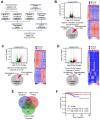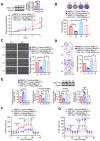DNMT3B-mediated FAM111B methylation promotes papillary thyroid tumor glycolysis, growth and metastasis
- PMID: 35864964
- PMCID: PMC9295055
- DOI: 10.7150/ijbs.72397
DNMT3B-mediated FAM111B methylation promotes papillary thyroid tumor glycolysis, growth and metastasis
Abstract
Over the past decades, the incidence of thyroid cancer (TC) rapidly increased all over the world, with the papillary thyroid cancer (PTC) accounting for the vast majority of TC cases. It is crucial to investigate novel diagnostic and therapeutic targets for PTC and explore more detailed molecular mechanisms in the carcinogenesis and progression of PTC. Based on the TCGA and GEO databases, FAM111B is downregulated in PTC tissues and predicts better prognosis in PTC patients. FAM111B suppresses the growth, migration, invasion and glycolysis of PTC both in vitro and in vivo. Furthermore, estrogen inhibits FAM111B expression by DNMT3B methylation via enhancing the recruitment of DNMT3B to FAM111B promoter. DNMT3B-mediated FAM111B methylation accelerates the growth, migration, invasion and glycolysis of PTC cells. In clinical TC patient specimens, the expression of FAM111B is inversely correlated with the expressions of DNMT3B and the glycolytic gene PGK1. Besides, the expression of FAM111B is inversely correlated while DNMT3B is positively correlated with glucose uptake in PTC patients. Our work established E2/DNMT3B/FAM111B as a crucial axis in regulating the growth and progression of PTC. Suppression of DNMT3B or promotion of FAM111B will be potential promising strategies in the estrogen induced PTC.
Keywords: DNMT3B; Estrogen; FAM111B; Glycolysis; Papillary thyroid cancer.
© The author(s).
Conflict of interest statement
Competing Interests: The authors have declared that no competing interest exists.
Figures







Similar articles
-
SLC34A2 simultaneously promotes papillary thyroid carcinoma growth and invasion through distinct mechanisms.Oncogene. 2020 Mar;39(13):2658-2675. doi: 10.1038/s41388-020-1181-z. Epub 2020 Jan 31. Oncogene. 2020. PMID: 32005974
-
Estrogen-mediated DNMT1 and DNMT3A recruitment by EZH2 silences miR-570-3p that contributes to papillary thyroid malignancy through DPP4.Clin Epigenetics. 2024 Jun 18;16(1):81. doi: 10.1186/s13148-024-01685-z. Clin Epigenetics. 2024. PMID: 38890707 Free PMC article.
-
MiR-146b-5p Regulates the Expression of Long Noncoding RNA MALAT1 and Its Effect on the Invasion and Proliferation of Papillary Thyroid Cancer.Cancer Biother Radiopharm. 2021 Jun;36(5):433-440. doi: 10.1089/cbr.2019.3322. Epub 2020 Apr 24. Cancer Biother Radiopharm. 2021. PMID: 32343601
-
Stress, Thyroid Dysregulation, and Thyroid Cancer in Children and Adolescents: Proposed Impending Mechanisms.Horm Res Paediatr. 2023;96(1):44-53. doi: 10.1159/000524477. Epub 2022 Apr 6. Horm Res Paediatr. 2023. PMID: 35385843 Review.
-
Unravelling the Intricate Roles of FAM111A and FAM111B: From Protease-Mediated Cellular Processes to Disease Implications.Int J Mol Sci. 2024 Feb 29;25(5):2845. doi: 10.3390/ijms25052845. Int J Mol Sci. 2024. PMID: 38474092 Free PMC article. Review.
Cited by
-
DNMT3B overexpression downregulates genes with CpG islands, common motifs, and transcription factor binding sites that interact with DNMT3B.Sci Rep. 2022 Dec 2;12(1):20839. doi: 10.1038/s41598-022-24186-6. Sci Rep. 2022. PMID: 36460706 Free PMC article.
-
Identification of prognostic genes related to T cell proliferation in papillary thyroid cancer based on single-cell RNA sequencing and bulk RNA sequencing data.Clin Exp Med. 2025 Aug 2;25(1):273. doi: 10.1007/s10238-025-01826-5. Clin Exp Med. 2025. PMID: 40753315 Free PMC article.
-
Identification and validation of a novel senescence-related biomarker for thyroid cancer to predict the prognosis and immunotherapy.Front Immunol. 2023 Jan 24;14:1128390. doi: 10.3389/fimmu.2023.1128390. eCollection 2023. Front Immunol. 2023. PMID: 36761753 Free PMC article.
-
The Prognosis-Predictive and Immunoregulatory Role of SUMOylation Related Genes: Potential Novel Targets in Prostate Cancer Treatment.Int J Mol Sci. 2023 Sep 2;24(17):13603. doi: 10.3390/ijms241713603. Int J Mol Sci. 2023. PMID: 37686409 Free PMC article.
-
Silencing of FAM111B inhibits tumor growth and promotes apoptosis by decreasing AKT activity in ovarian cancer.Exp Biol Med (Maywood). 2023 Jun;248(12):1043-1055. doi: 10.1177/15353702231160326. Epub 2023 Apr 24. Exp Biol Med (Maywood). 2023. PMID: 37095701 Free PMC article.
References
Publication types
MeSH terms
Substances
LinkOut - more resources
Full Text Sources
Medical
Miscellaneous

